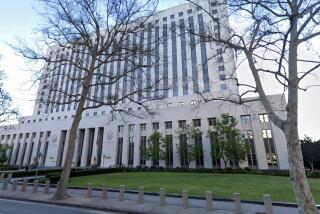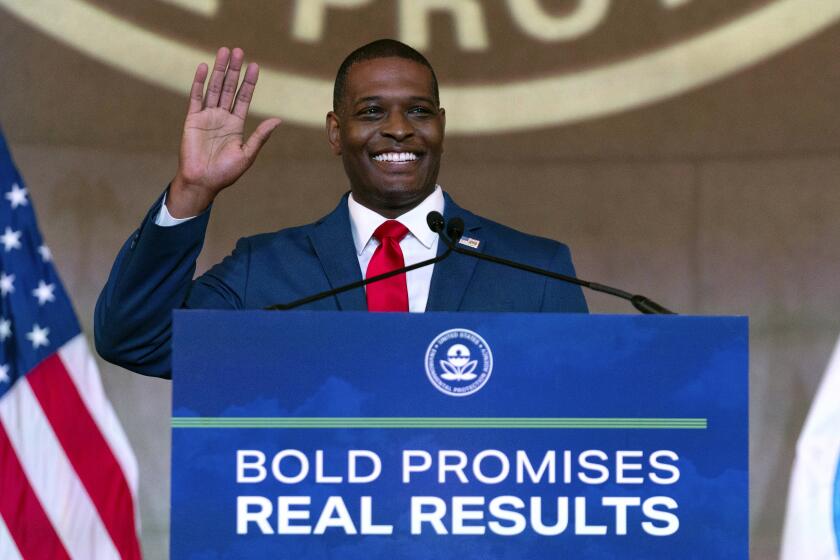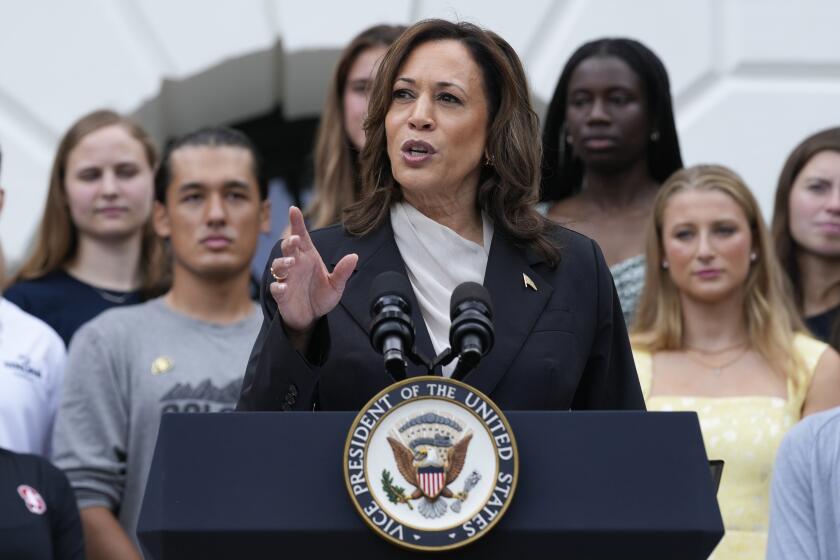S.F. Growing Edgier From War Protests
Weary police arrested more than 300 antiwar protesters in a series of isolated face-offs here Friday, one day after authorities arrested more than 1,400 in demonstrations that shut down parts of the financial district and temporarily closed the San Francisco-Oakland Bay Bridge.
The arrests in San Francisco’s second day of protests roughly equaled the number made across the rest of the nation Friday.
In West Los Angeles, 150 demonstrators kicked at cars and blocked traffic on Santa Monica Boulevard.
Baltimore protestors dropped to the ground in a “die-in” and 30 were arrested.
In Columbus, Ohio, demonstrators brought shaving cream, toothpaste and other supplies for the soldiers -- among the hundreds nationwide supporting of the war.
Authorities expected more action today at rallies scheduled from coast to coast.
Police in San Francisco were kept on edge into Friday night by the activists’ unpredictable maneuvers and by the earlier discovery of a dozen Molotov cocktails in a downtown alley.
The FBI and the federal Bureau of Alcohol, Tobacco, Firearms and Explosives were investigating the devices, a bag of rags and lighter fluid discovered outside the Fairmont Hotel.
“We’re taking the findings very seriously,” said San Francisco police spokesman Dewayne Tully. “What we don’t know is how many more are out there. And how many could be used.”
While protesters congratulated themselves for bringing attention to their antiwar cause, many wondered if their helter-skelter forays were driving away potential supporters.
Participants in Thursday’s massive “first day” antiwar demonstration said they were pleased at how 10,000 activists were able to shut down dozens of streets and halt work at a major defense contractor.
But Mayor Willie Brown reacted angrily to the demonstrators for turning a protest into a “riot.”
“I’m really disappointed that the quality and level of protest that has been the hallmark of this city is being depreciated by anarchists and opportunists,” Brown said Friday. “San Francisco is famous for being incredibly tolerant, even for these kinds of nuts and screwballs.”
Brown estimated that the city will spend more than $500,000 a day to cope with protesters, most of whom he said don’t even live in San Francisco. On Thursday, he criticized the demonstrators for using hammers to break the windows of police cars, and Friday he said the discovery of old liquor bottles, each filled with gasoline and a wick, raised a new level of concern.
“I immediately assumed somebody wanted to do some terrorist stuff,” Brown said. “I think even some protesters have become aghast over what they’re associated with.”
Ed Sarpolus, an independent political pollster in Lansing, Mich., agreed that the activists run the risk of squandering public sympathy. “The problem with the demonstrations, as with the [World Trade Organization] riots a few years back, is the fact they crossed the line. Once you get into violent attacks, then the public turns away from you.”
Peverill Squire, a political science professor at the University of Iowa, said the rest of America might write off the actions as the work of California extremists, adding that pictures of protesters he’s seen on TV “really looked more like a Deadhead reunion than a mass movement.”
Squire added: “It probably doesn’t suggest to most people this is a really broad-based movement.”
Some organizers worried that moderates might be alienated by violent demonstrations.
“The most obvious negative,” said Jason Mark, a spokesman for San Francisco-based Global Exchange, “is that it is written off as, ‘That’s just San Francisco.’ ”
Protest organizer Leda Dederich said, despite a commitment to nonviolence, “in every movement in the last 50 years, there have always been folks who come in with violent tendencies.”
Dederich suggested that the homemade devices found Friday might be “the work of agents provocateurs implanted by the government as a way to discredit the movement.”
Police spokesman Tully said that, athough the streets of the city were “comparatively quiet, eerily quiet,” all of the department’s 2,250 officers remained on the streets. Police are “tired and they’re frustrated,” Tully said. “They’re working 12-hour shifts playing a cat-and-mouse game with protesters.”
Police pledged to continue more aggressive tactics. On Friday, they collared a group of protesters who tried to enter the San Francisco offices of Sen. Dianne Feinstein. Hours earlier, they had arrested 60 people outside the offices of a government contractor.
Instead of racing down the street, activists paraded down sidewalks, even pausing for traffic lights. Many protesters said they did not want to chance arrest and having to spend the weekend in custody.
*
Times staff writer Mark Z. Barabak contributed to this report.
More to Read
Sign up for Essential California
The most important California stories and recommendations in your inbox every morning.
You may occasionally receive promotional content from the Los Angeles Times.







